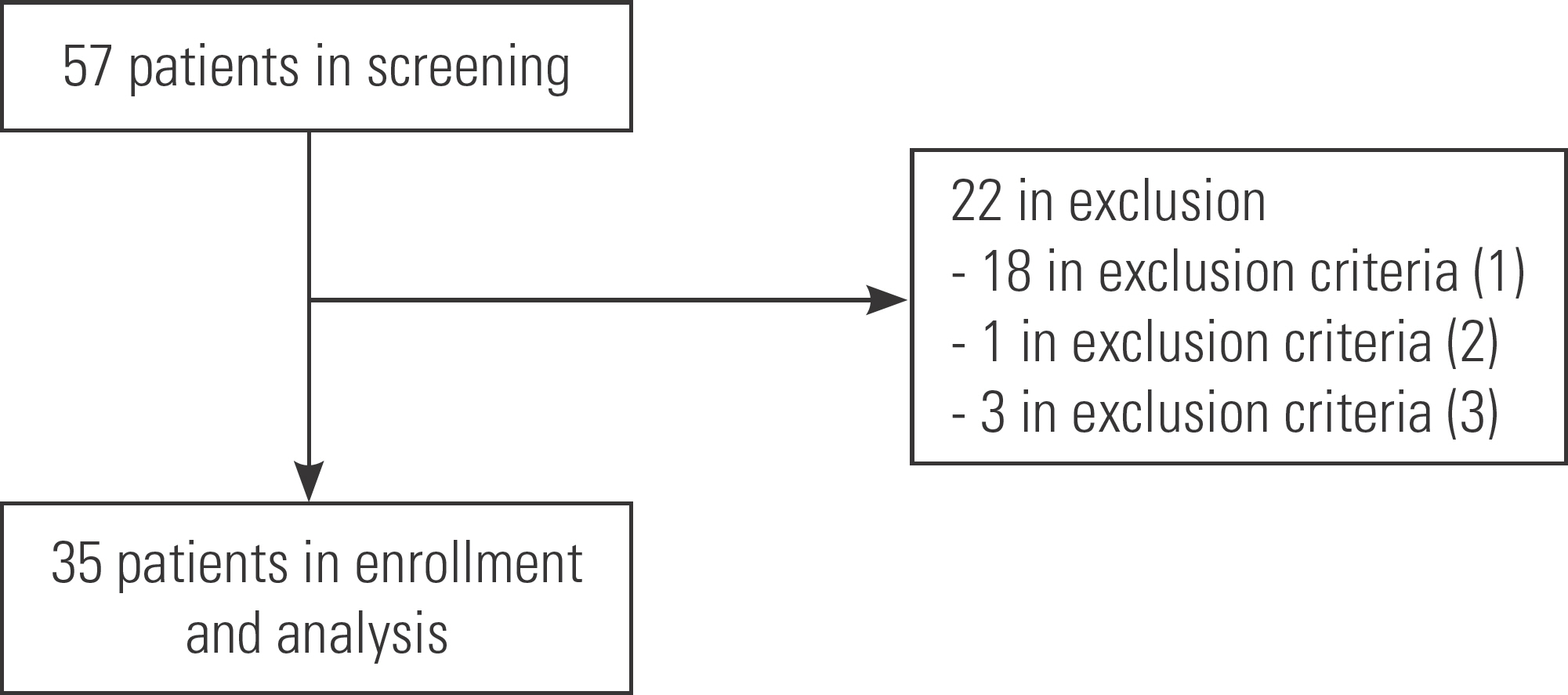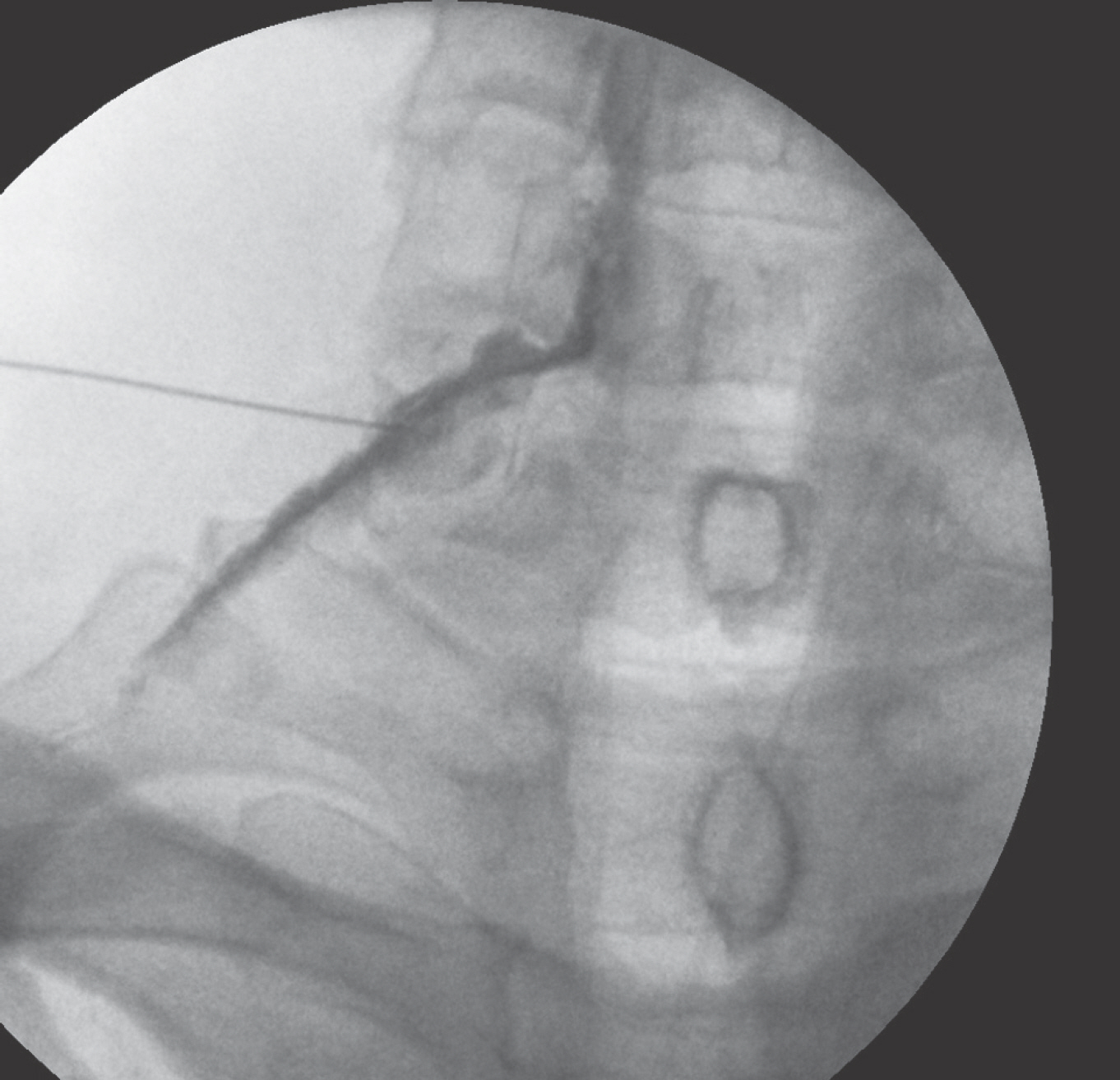J Korean Soc Spine Surg.
2019 Jun;26(2):40-49. 10.4184/jkss.2019.26.2.40.
When is the Optimal Time Point for Predicting the 1-Year Follow-up Outcome of Selective Nerve Root Block for Cervical Radiculopathy?
- Affiliations
-
- 1Department of Orthopaedic Surgery, Yeungnam University Medical Center, Yeungnam University College of Medicine, Daegu, Korea. gwlee1871@gmail.com
- KMID: 2451312
- DOI: http://doi.org/10.4184/jkss.2019.26.2.40
Abstract
- STUDY DESIGN: Retrospective study.
OBJECTIVES
In the current study, we aimed to (1) evaluate the early and late therapeutic effects of selective nerve root block (SNRB) for cervical radiculopathy, and (2) to determine the optimal time point for predicting the long-term effectiveness of cervical SNRB. SUMMARY OF LITERATURE REVIEW: Although SNRB is an important option for cervical radiculopathy, various studies of cervical SNRB have failed to specify its efficacy, especially long-term effectiveness.
MATERIALS AND METHODS
We retrospectively enrolled 35 patients with cervical radiculopathy who were regularly followed-up for at least 1 year after SNRB. Clinical outcomes were evaluated using a visual analogue scale (VAS) for pain intensity and the modified Kim's method for patient satisfaction at regular follow-up intervals. In the correlation analysis, stepwise multiple linear regression was used to identify selected and unselected factors.
RESULTS
The average VAS score decreased over time (p<0.05); the values just before the injection and at 1 week, 3 weeks, and 1 year of follow-up were 6.11, 3.29, 2.89, and 1.37, respectively. In the stepwise multiple regression analysis, the 1-week VAS score was related to the initial VAS score, the 3-week VAS score was related to the 1-week VAS score, and the last VAS score was related to the 3-week VAS score and symptom duration before the injection. The degree of satisfaction at the 1-year follow-up point was significantly associated with the 3-week VAS score (p=0.011).
CONCLUSIONS
The current study showed that pain intensity at the 3-week time point after cervical SNRB might be the optimal time point for predicting long-term effectiveness.
Keyword
MeSH Terms
Figure
Reference
-
1. Desai A, Saha S, Sharma N, Huckerby L, Houghton R. The short- and medium-term effectiveness of CT-guided selective cervical nerve root injection for pain and disability. Skeletal Radiol. 2014 Jul; 43(7):973–8. DOI: 10.1007/s00256-014-1843-4.
Article2. Chung JY, Yim JH, Seo HY, Kim SK, Cho KJ. The Efficacy and Persistence of Selective Nerve Root Block under Fluo-roscopic Guidance for Cervical Radiculopathy. Asian Spine J. 2012 Dec; 6(4):227–32. DOI: 10.4184/asj.2012.6.4.227.
Article3. Radhakrishnan K, Litchy WJ, O'Fallon WM, Kurland LT. Epidemiology of cervical radiculopathy. A population-based study from Rochester, Minnesota, 1976 through 1990. Brain. 1994 Apr; 117(Pt 2):325–35. DOI: 10.1093/brain/117.2.325.4. Johansson A, Hao J, Sjolund B. Local corticosteroid appli-cation blocks transmission in normal nociceptive C-fibres. Acta Anaesthesiol Scand. 1990 Jul; 34(5):335–8. DOI: 10.1111/j.1399-6576.1990.tb03097.x.
Article5. Yabuki S, Kawaguchi Y, Nordborg C, Kikuchi S, Rydevik B, Olmarker K. Effects of lidocaine on nucleus pulposus-induced nerve root injury. A neurophysiologic and histo-logic study of the pig cauda equina. Spine (Phila Pa 1976). 1998 Nov; 23(22):2383–90. DOI: DOI:10.1097/00007632-199811150-00004.6. Park Y, Ahn JK, Sohn Y, et al. Treatment Effects of Ultra-sound Guide Selective Nerve Root Block for Lower Cervical Radicular Pain: A Retrospective Study of 1-Year Follow-up. Ann Rehabil Med. 2013 Oct; 37(5):658–67. DOI: 10.5535/arm.2013.37.5.658.
Article7. Hodler J, Boos N, Schubert M. Must we discontinue selective cervical nerve root blocks? Report of two cases and review of the literature. Eur Spine J. 2013 May; 22(3 Suppl):S466–70. DOI: 10.1007/s00586-012-2642-z.8. Bono CM, Ghiselli G, Gilbert TJ, et al. An evidence-based clinical guideline for the diagnosis and treatment of cervical radiculopathy from degenerative disorders. Spine J. 2011 Jan; 11(1):64–72. DOI: 10.1016/j.spinee.2010.10.023.
Article9. House LM, Barrette K, Mattie R, McCormick ZL. Cervical epidural steroid injection: Techniques and evidence. Phy Med Rehabil Clin N Am. 2018 Feb; 29(1):1–17. DOI: 10.1016/j.pmr.2017.08.001.10. Kaye AD, Manchikanti L, Abdi S, et al. Efficacy of epidural injections in managing chronic spinal pain: A best evidence synthesis. Pain Physician. 2015 Nov; 18(6):E939–1004. DOI: 10.1016/j.spinee.2010.10.023.11. Woods BI, Hilibrand AS. Cervical radiculopathy: epidemiology, etiology, diagnosis, and treatment. J Spinal Disord Tech. 2015 Jun; 28(5):E251–9. DOI: 10.1097/BSD.0000000000000284.12. Corey DL, Comeau D. Cervical radiculopathy. Med Clin North Am. 2014 Jul; 98(4):791–9. DOI: 10.1016/j.mcna.2014.04.001.
Article13. Diwan S, Manchikanti L, Benyamin RM, et al. Effectiveness of cervical epidural injections in the management of chronic neck and upper extremity pain. Pain Physician. 2012 Jul-Aug; 15(4):E405–34.14. Klessinger S, Freund W, Karpel-Massler G, Halatsch ME. Response to transforaminal injection of steroids and correlation to mri findings in patients with cervical radicular pain or radiculopathy due to disc herniation or spondylosis. Pain Med. 2014 Jun; 15(6):929–37. DOI: 10.1111/pme.12415.
Article15. Ray WZ, Akbari S, Shah LM, Bisson E. Correlation of Foraminal Area and Response to Cervical Nerve Root Injections. Cureus. 2015 Jul; 7(7):e286. DOI: 10.7759/cu-reus.286.
Article16. Chen B, Rispoli L, Stitik TP, Foye PM, Georgy JS. Optimal needle entry angle for cervical transforaminal epidural injections. Pain Physician. 2014 Mar-Apr; 17(2):139–44.17. Schellhas KP, Pollei SR, Johnson BA, Golden MJ, Eklund JA, Pobiel RS. Selective cervical nerve root blockade: expe-rience with a safe and reliable technique using an anterolateral approach for needle placement. AJNR Am J Neuroradiol. 2007 Nov-Dec; 28(10):1909–14. DOI: 10.3174/ajnr. A0707.
Article18. Kim HS, Yoon US, Seo JS, Kim YJ, Jo SM. Efficacy of Epidural Steroid Injection in Lumbar Spinal stenosis. J Kor Spine Surg. 2005; 12(4):310–5. DOI: 10.4184/jkss.2005.12.4.310.
Article19. Huston CW, Slipman CW. Diagnostic selective nerve root blocks: indications and usefulness. Phys Med Rehabil Clin N Am. 2002 Aug; 13(3):545–65. DOI: 10.3174/ajnr. A0707.
Article20. Yeom JS, Lee JW, Park KW, et al. Value of diagnostic lumbar selective nerve root block: a prospective controlled study. AJNR Am J Neuroradiol. 2008 May; 29(5):1017–23. DOI: 10.3174/ajnr.A0955.
Article21. Anderberg L, Annertz M, Rydholm U, Brandt L, Saveland H. Selective diagnostic nerve root block for the evaluation of radicular pain in the multilevel degenerated cervical spine. Eur Spine J. 2006 Jun; 15(6):794–801. DOI: 10.1007/s00586-005-0931-5.
Article22. Mallinson PI, Tapping CR, Bartlett R, Maliakal P. Factors that affect the efficacy of fluoroscopically guided selective spinal nerve root block in the treatment of radicular pain: a prospective cohort study. Can Assoc Radiol J. 2013 Nov; 64(4):370–5. DOI: 10.1016/j.carj.2013.03.001.
Article23. Engel A, King W, MacVicar J. The effectiveness and risks of fluoroscopically guided cervical transforaminal injections of steroids: a systematic review with comprehensive analysis of the published data. Pain Med. 2014 Mar; 15(3):386–402. DOI: 10.1111/pme.12304.
Article24. Vallee JN, Feydy A, Carlier RY, Mutschler C, Mom-point D, Vallee CA. Chronic cervical radiculopathy: lateral-approach periradicular corticosteroid injection. Radiology. 2001 Mar; 218(3):886–92. DOI: 10.1148/radiology.218.3.r01mr17886.
Article25. Takeuchi M, Kamiya M, Wakao N, et al. A simple, 10-minute procedure for transforaminal injection under ultrasonic guidance to effect cervical selective nerve root block. Neurol Med Chir (Tokyo). 2014 Mar; 54(9):746–51. DOI: 10.2176/nmc.oa.2013-0332.
Article26. Hirpara KM, Butler JS, Dolan RT, O'Byrne JM, Poynton AR. Nonoperative modalities to treat symptomatic cervical spondylosis. Adv Orthop. 2012 Aug; 2012:294857. DOI: 10.1155/2012/294857.
Article27. Lee HM, Weinstein JN, Meller ST, Hayashi N, Spratt KF, Gebhart GF. The role of steroids and their effects on phospholipase A2. An animal model of radiculopathy. Spine (Phila Pa 1976). 1998 Jun; 23(11):1191–6. DOI: DOI:10.1097/00007632-199806010-00001.28. Pfirrmann CW, Oberholzer PA, Zanetti M, et al. Selective nerve root blocks for the treatment of sciatica: evaluation of injection site and effectiveness–a study with patients and cadavers. Radiology. 2001 Dec; 221(3):704–11. DOI: 10.1148/radiol.2213001635.
Article29. Jee H, Lee JH, Kim J, Park KD, Lee WY, Park Y. Ultrasound-guided selective nerve root block versus fluoroscopy-guided transforaminal block for the treatment of radicular pain in the lower cervical spine: a ran-domized, blinded, controlled study. Skeletal Radiol. 2013 Jan; 42(1):69–78. DOI: 10.1007/s00256-012-1434-1.
Article
- Full Text Links
- Actions
-
Cited
- CITED
-
- Close
- Share
- Similar articles
-
- Acute Spinal Cord Injury after Cervical Nerve Root Block
- The Value of Selective Nerve Root Block to Predict Surgical Outcome for Spinal Surgery
- The Efficacy and Persistence of Selective Nerve Root Block under Fluoroscopic Guidance for Cervical Radiculopathy
- Transient quadriplegia after fluoroscopic-guided selective cervical nerve root block in a patient who received cervical interbody fusion: A case report
- Cervical Radiculopathy: Selective Nerve Root Injection of Steroids



